Gameplay
When starting the game, players are prompted to select an arm, body, and legs for their cyborg character. Enemies are also a combination of these three types of cyborg parts, even having the secondary arm mixed. When players choose the "two players game mode," players will be prompted to the customization room, and afterwards either go to the main adventure mode or the duel mode if they previously set it in the Options menu. The first player has a combination of metallic gray and yellow, while the second player has a combination of metallic green and purple.
Enemies come in pairs, with first and second player colors respectively. Players have a wide variety of moves, which includes picking up and using objects and manipulating enemies, grabbing the enemy's arm and removing it, and swap it for the current arm, and if the enemy does not have a primary arm, then the next thing the player can grab is the body and tear the enemy in half, which can then be drained to replenish energy.
As the levels progress, the player is confronted with cyborg enemies sporting different modified bodies. If desired, the player can swap out parts from defeated enemies by kicking the wreckage and grasping downward at the displayed item. This is sometimes needed, such as in the first level where the player is faced with an enemy with high-jump legs and then has to jump across a wide chasm. Later on, battles with enemies become increasingly difficult. The more powerful weapons from defeated enemies prove essential in defeating the next wave of foes or end-level bosses.
In easy mode, there are 3 stages, and 3 levels of each stage, and a boss at the 3rd level of each stage. In stage 1, the player finds themselves turned into a cyborg after their space ship crashed, but their memory erasure had failed, causing the player to become a rebel cyborg, fighting for freedom and to destroy whoever turned the player into a cyborg. Stage 1 is the outskirts of the planet, with sparse civilization. On the 3rd level of stage 1, there is a boss that the player must defeat in order to progress to the next stage. Once beaten, the player progresses to stage 2, level 1. In stage 2, the player finds themselves inside of a building, and must fight through all 3 levels of stage 2 to progress to stage 3. In stage 3, the player finds themselves in an industrial setting. In easy mode, when the player defeats the boss in stage 3, level 3, the player wins the game. Each level of each stage is a different color of the one previous. This was one of the main problems with this game, as people criticize its repetitive maps.
In brutal mode, the hardest possible difficulty, there are 5 stages, and the "Main Boss." Stages 1-3 are the same as stages 1-3 in easy mode, except the enemy cyborgs that the player must fight are stronger. In stage 4, the player finds themselves on a futuristic space-station, where they must battle through all 3 levels of stage 4 to progress to stage 5. In stage 5, the player finds themselves in an eerie cave with sparse technology. There is no boss at the end of the third level of stage 5. Instead, the player progresses to another stage that consists of 1 level. This is the "Main Boss." The player finds themselves in the lair of the Brainiac, a giant brain that the player must defeat to win the game. To defeat the Brainiac, the player must destroy all 3 modules located on the front of the brain, while dodging the array of lasers that return every 2 seconds. When the lasers return, a portion of the lasers fire, leaving little room for the player to avoid getting hit. after the lasers shoot, they slide off screen, and the player is able to hit the Brainiac once more. When the Brainiac is defeated, the player officially "Wins" the game, and the credits are shown. At the end of the credits, the player is asked to input their name, where their score will be displayed.
Enemy cyborgs appear in pairs of two. The first cyborg is always in front of the player, at the top of the fighting zone. Then a second cyborg appears behind the player, at the bottom of the fighting zone. This fighting aspect of the game does not change. The player must defeat both cyborgs to move forward, where the player must defeat 2 more. At the end of a stage without a boss, the player's hovering vehicle swoops in, and the player jumps in and flies off screen, then the player's level points are rewarded and they progress to the next level of the current stage. When the player kills another cyborg, it takes 5 seconds for them to explode, so the player can move forward. The player can also crouch, and hit the corpse to make it explode faster. The player can also low-kick the body, forcing the legs up. the player can then switch legs. The player can also remove other cyborgs' arms, during a fight. The player cannot perform this move to any bosses, except for the stage 1 boss. Torsos cannot be switched, as the torso hold the player's human brain.
Special Moves
Some fighting moves are unique to a specific body part. At the start of the game, the player is able to choose their Torso, primary arm, and legs. Available Arms: Cannon Arm, Flamethrower Arm, Saw Arm, Regular Arm. The player cannot change their other arm. The cannon arm can shoot, the flamethrower spews fire, the saw arm can cut, and the regular arm will just punch. Torsos do not give any extra fighting moves, but they do offer speed and health bonuses. There are multiple legs to choose from. The Pneumatic Legs, the Summersault Legs, the Big Legs, and the Tank Legs give special bonuses. the pneumatic legs offer greater kicking power, the summersault legs increase agility and enable the player to summersault, the big legs are immune to floor traps, and the tank legs allow the player to transform their legs into tank tracks, and "dash." The tank legs will hurt enemies if they come in contact with the player while they're "Dashing." There are multiple arms that the player can only acquire by taking them off enemies, such as the missile arm, The piston arm, and more. The player can also jump onto enemies and perform a move that drains health from the enemy and heals the player.

Animaniacs is a series of platform video games developed by Konami, based on the animated series of the same name. Two games were developed featuring significantly different gameplay and storylines; one for Super Nintendo Entertainment System, and one for the Sega Mega Drive/Genesis and Game Boy. The SNES and Genesis versions were released in 1994, and the Game Boy version in 1995.
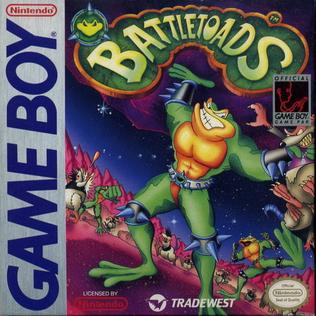
Battletoads is a 1991 action game originally released by Rare in 1991 exclusively for the Game Boy handheld game console from Nintendo. Despite having the same title as the original Battletoads game, Battletoads for Game Boy is a completely different game with unique levels. It was never ported to any other systems.

Joy Mech Fight, sometimes called Joy Mecha Fight, is a fighting game developed and published by Nintendo for the Family Computer, released only in Japan on May 21, 1993. The game was released during the generation shift between the Famicom and the newer Super Famicom, and Joy Mech Fight is counted among the most important late Famicom games for utilizing the console's audio and visual capabilities to the fullest extent. It is also Nintendo's first attempt in the fighting game genre since Urban Champion after the success and craze of Capcom's Street Fighter II, which inspired other companies to create their own 2D fighters.

Nova 9: The Return of Gir Draxon is a futuristic shooter video game developed by Dynamix and released by Sierra On-Line in 1991 for the PC as the second sequel to the game Stellar 7.
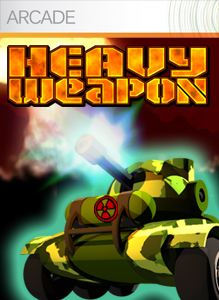
Heavy Weapon is a horizontally scrolling shooter developed and published by PopCap Games and released in 2005.

Mutant Storm Reloaded is a multi-directional shoot 'em up developed by PomPom Games. The game debuted as a launch title on the Xbox 360's Xbox Live Arcade service with updated graphics, sound, and gameplay over its Windows and Xbox predecessor, Mutant Storm.

The Death and Return of Superman is a side-scrolling beat 'em up video game released by Sunsoft for the Super NES and Genesis in 1994. It is based on "The Death of Superman" comic book storyline by DC Comics and features many characters from the comics, including Superman himself, Superboy, Steel, Cyborg Superman, the Eradicator, and Doomsday. All of the five Supermen are playable characters at some point.
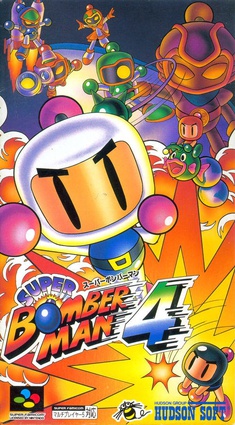
Super Bomberman 4 is a multiplayer action-party video game, developed by Produce and published by Hudson Soft for the Super Famicom, released on April 26, 1996, in Japan. Part of the Bomberman franchise, it is the fourth installment of the Super Bomberman series.

Superman: The Man of Steel is an action-adventure video game for Xbox, based on DC Comics' character Superman. It was developed by Circus Freak, and published by Infogrames under the Atari brand name and released in conjunction with Warner Bros. Interactive Entertainment and DC Comics. It is based on the comic book mythos, as opposed to most other Superman games which are adaptations of the character in other mediums besides the source material.

Nucleus is a twin-stick shooter with puzzle elements for the PlayStation 3 available through the PlayStation Store. It was released as Bacterius in Japan.

Monster Maulers, known in Japan as Kyukyoku Sentai Dadandarn, is a 1993 fighting arcade game developed and published by Konami.

The Dishwasher: Dead Samurai is a beat 'em up game developed by independent software developer James Silva for the Xbox 360's Xbox Live Arcade service.

Time Slip is a platform action video game developed by Sales Curve Interactive and published by Vic Tokai, featuring the adventures of Dr. Vincent Gilgamesh, a scientist attempting to foil an alien invasion to Earth by traveling to different historic ages. This game was only released to the Super Nintendo Entertainment System.

Mechwarrior: Living Legends is a free, fan-created multiplayer-only game based in the BattleTech universe - originally a total-conversion mod for Crysis, it's since become stand-alone - running on Crysis Wars, and using CryEngine 2 as its engine. It's one of the few mods based on the BattleTech universe to have been sanctioned by Microsoft—who currently owns the rights to the Mechwarrior video-game franchise—and additionally received pre-SDK support and sanctioning directly from Crytek, producers of the games' engine. On December 26, 2009, an open beta was released via BitTorrent and other distribution methods. Because the project changes the play-style and feel of the game it is originally based on so completely as to be unrecognizable in comparison, it is billed as a "full-conversion" mod, since little to no trace of the original game's art or play-style exists any longer within MW:LL. It was created by American developer Wandering Samurai Studios.

Zuma's Revenge! is a 2009 tile-matching puzzle video game developed and published by PopCap Games. It was released for Microsoft Windows and Mac OS X, as a sequel to the earlier 2003 video game, Zuma, and was later ported to Windows Phone.
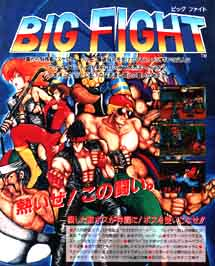
Big Fight (ビッグファイト), fully titled as Big Fight: Big Trouble in the Atlantic Ocean, is a 1992 fighting game / belt scrolling beat 'em up-hybrid arcade game developed and published by Tatsumi, and is one of their last arcade games before focusing on novelty sticker printing business. Tatsumi added two different modes to Big Fight: a beat 'em up mode and a versus fighting game mode.

Minotron: 2112 is a video game for iOS written by Jeff Minter and Ivan Zorzin of Llamasoft. It is a remade mobile version of Llamatron for the Atari ST and Amiga, which itself is an updated version of the 1982 arcade game Robotron: 2084. It is the Minotaur Project game representing the Mattel Intellivision.
Bomberman GB is a video game series created by Hudson Soft for the Game Boy. The first entry was Bomberman GB, released as Wario Blast: Featuring Bomberman! in North America and Europe, later succeeded by Bomberman GB 2, under the name Bomberman GB internationally, and Bomberman GB 3, which was only released in Japan.
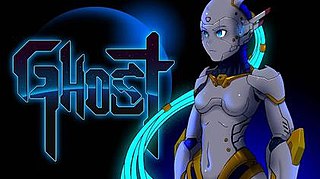
Ghost 1.0 is a Metroidvania video game developed and published by Francisco "franfistro" Téllez de Meneses, the developer of Unepic, in collaboration with an unnamed development team. It was released on June 7, 2016 for the digital distribution platform Steam and later for GOG. It was released for the Xbox One and Nintendo Switch in July 2018 and for PlayStation 4 in April 2019.
Clone Drone in the Danger Zone is a beat 'em up video game developed and published by Doborog Games. It was initially made available as an early access game on Steam in 2017. Before the Steam release however, it was originally made on Itch.io, which was also made in 2017, and was released for macOS and Microsoft Windows via Steam, Nintendo Switch, PlayStation 4, and Xbox One on July 27, 2021.
















